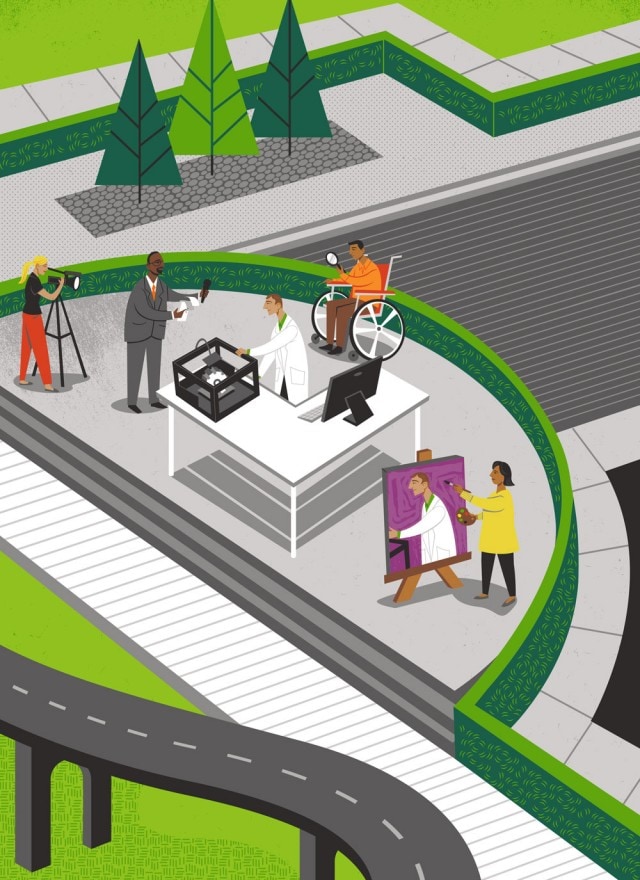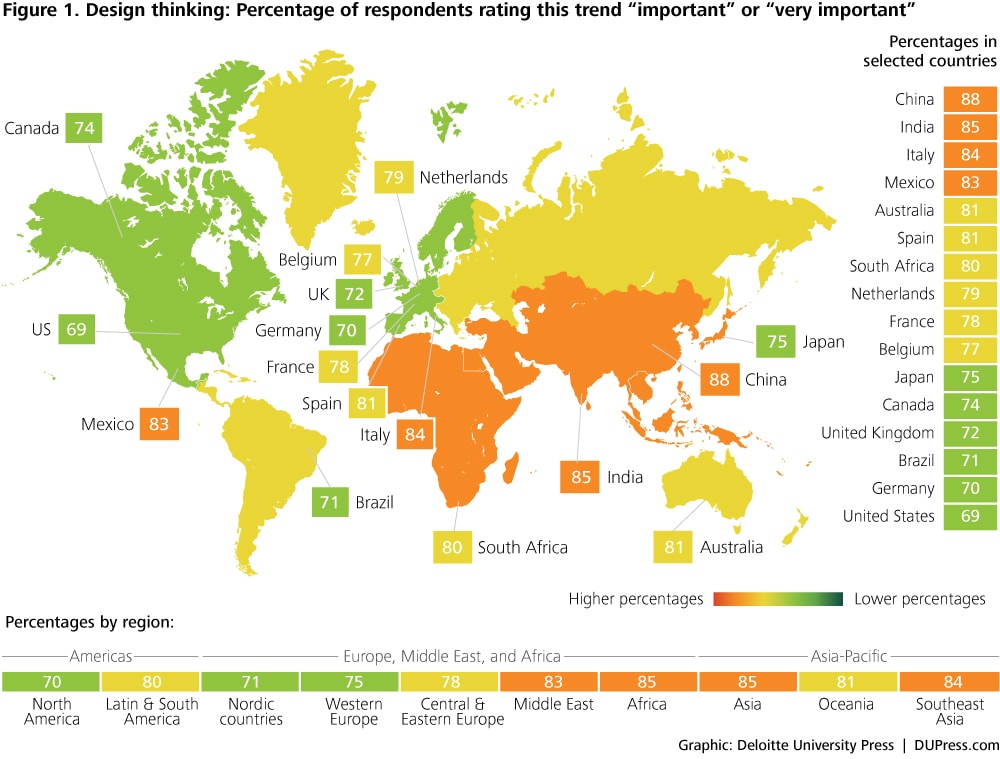Design thinking has been saved

Design thinking Crafting the employee experience
01 March 2016
Design thinking takes aim at the heart of unnecessary workplace complexity by putting the employee experience first—helping to improve productivity by designing solutions that are at once compelling, enjoyable, and simple.
View the complete Global Human Capital Trends 2016 report
Explore
View 2016 Global Human Capital Trends
Create and download a custom PDF
Watch the related video
Explore the related infographic
Employees are overwhelmed with technology, applications, and a constant flood of information. Deloitte research shows that people collectively check their phones more than 8 billion times each day,1 yet productivity is barely rising.2 To relieve the overwhelmed employee and develop HR applications that can help manage complexity, HR must adopt design thinking, which puts the employee experience at the center.3 Design thinking moves HR’s focus beyond building programs and processes to a new goal: designing a productive and meaningful employee experience through solutions that are compelling, enjoyable, and simple.
- Design thinking provides a means to focus on the employee’s personal experience and to create processes centered upon the worker. The result: new solutions and tools that directly contribute to employee satisfaction, productivity, and enjoyment.
- HR departments should upgrade their skills to incorporate key design thinking concepts such as digital design, mobile app design, user experience design, and behavioral economics.
- Design thinking is important, and it works. In this year’s survey, respondents at companies where HR delivers the highest levels of value are almost five times more likely to be using design thinking in their programs than their peers.4
 Traditional HR solutions are typically programs or processes to train people, assess performance, ensure compliance, or document a practice at work. Most were built around forms, process steps, formal training, or classroom events. While these strategies work to a degree, today’s employees are already overwhelmed with a flood of email, messages, meetings, and other workplace distractions. Two-thirds of companies now believe complexity is an obstacle to business success and a barrier to growth in business productivity.5 Perhaps this is one reason why 79 percent of executives in this year’s Global Human Capital Trends survey rated design thinking an important or very important issue. (See figure 1 for our survey respondents’ ratings of design thinking’s importance across global regions and selected countries.)
Traditional HR solutions are typically programs or processes to train people, assess performance, ensure compliance, or document a practice at work. Most were built around forms, process steps, formal training, or classroom events. While these strategies work to a degree, today’s employees are already overwhelmed with a flood of email, messages, meetings, and other workplace distractions. Two-thirds of companies now believe complexity is an obstacle to business success and a barrier to growth in business productivity.5 Perhaps this is one reason why 79 percent of executives in this year’s Global Human Capital Trends survey rated design thinking an important or very important issue. (See figure 1 for our survey respondents’ ratings of design thinking’s importance across global regions and selected countries.)
Design thinking casts HR in a new role.6 It transforms HR from a “process developer” to an “experience architect.” It empowers HR to reimagine every aspect of work: the physical environment; how people meet and interact; how managers spend their time; and how companies select, train, engage, and evaluate people. One CHRO calls herself the “chief employee experience officer,” which effectively summarizes this powerful new mandate.
Design thinking—or lack of it—can make a huge difference in how companies are perceived.
Simply described, design thinking means focusing on the person and the experience, not the process. At its core, working as a designer involves studying people at work, and developing “personas” and “profiles” to understand employee demographics, work environment, and challenges. It relies on generating ideas quickly and testing prototypes that generate further ideas, digital tools, and solutions.7
Applying design thinking to the work experience compels HR to ask, “What does a great employee experience look like from end to end? How can we facilitate collaboration and learning in everything we do? How can we take advantage of location-aware mobile devices to make people more productive? How can we give employees a few easy-to-understand choices so they can make decisions faster?”
Many companies are relying upon design thinking. GE, for example, has made simplification a core new business strategy.8 It is introducing design thinking, a simplified model for performance management, new mobile apps for goal management and collaboration, and a new set of principles for work. The company now uses agile methodologies throughout product development and is teaching managers how to help teams “do less” and “focus more.”
One fundamental idea in design thinking is the use of behavioral economics. Many HR practices can be replaced with “intelligent choices,” using the principles of behavioral economics to encourage better decisions.9 Should a company, for example, give people 10 options for 401(k) plans? Or rather select three that offer the best performance? Such “choice architecture” can make work far easier and more enjoyable for employees—and increase employee participation in the program.
Design thinking—or lack of it—can make a huge difference in how companies are perceived. Take recruiting. The Talent Board found that more than half the candidates who find the job-application experience difficult develop a negative impression of the company’s products and services.10 Companies such as Zappos and others design the candidate experience to attract high-performing people and make it easy to find the right job and apply quickly.11
Other companies are using design thinking to improve learning dramatically. Deckers Brands,12 Nestlé,13 and Qualcomm14 have used design thinking to develop highly intuitive, experiential learning programs. Experiential learning programs begin with the individual and the context of an employee’s work rather than a model in which the presenter is the focus. They offer learning programs that are much more stimulating and engaging and lead to higher skills retention. In addition, they do not depend on a learning management system but can leverage new learning technologies to promote continuous learning.
The data from our survey this year suggest that the more importance an organization places on design thinking and the more ready it is to embrace it, the faster the organization grows. Companies growing by 10 percent or more per year are more than twice as likely to report they are ready to incorporate design thinking, compared to their counterparts that are experiencing stagnant levels of growth.
Exciting new digital tools that employ design thinking are also making routine HR tasks more efficient and easy, while improving the employee experience. Australia and New Zealand Banking Group developed an easy-to-use mobile app that allows employees to manage their time and attendance, benefits, and vacation schedule, while also enabling them to collaborate with colleagues.15 DuPont completely redesigned its online HR portal around the end user’s experience, dramatically reducing the time employees spend on traditional HR management processes.16 Beyond recruiting, learning, and other HR processes, design thinking has been used to improve performance management and coaching at companies such as Adobe,17 and Autodesk,18 and New York Life.
The data from our survey this year suggest that the more importance an organization places on design thinking and the more ready it is to embrace it, the faster the organization grows.
Organizations are also starting to use employee personas to understand the unique needs of distinct employee segments. At one Australian government agency, eight personas were considered as the agency was designing a new HR portal. The organization found that 27,000 of its 45,000 employees were remote field workers who do not use company-sponsored technology and function independently. Through focus groups and a survey, the agency uncovered surprising and practical insights around communication, collaboration and knowledge management, and self-service administration across all personas. For example, the biggest frustration for these remote employees was the inability to access their work schedules, submit absence requests, or order uniforms using their personal technology. These insights guided the systems design. Today, the employee persona profiles are a standard component of the agency’s orientation program.19
With more companies embracing design thinking, we see it connecting many of the trends we highlight this year, including:
- Organizational design, which can incorporate design thinking when restructuring roles or the organization itself
- Engagement, which research shows can be driven by using design thinking to make work easier, more efficient, more fulfilling, and more rewarding
- Learning, in which new, self-directed learning experiences can be shaped by design thinking’s central principle of putting the user experience ahead of the process
- Analytics, in which data analysis and design thinking can be linked to recommend better solutions directly to the employee
- HR skills, which must be upgraded to incorporate an understanding of digital design, mobile application design, behavioral economics, machine learning, and user experience design
- Digital HR, where design thinking is critical in developing new digital tools that can make work easier and better
Just as successful companies continually ask how to improve customer experiences and how those experiences compare to their competitors’, HR can approach employee experiences with the same rigor. While design thinking may involve significant changes to workplaces, systems, processes, and other business elements, its focus is on people.
As a recent Harvard Business Review article by Jon Kolko noted, “People need their interactions with technologies and other complex systems to be simple, intuitive, and pleasurable.” Because “design is empathetic,” the article continues, “it implicitly drives a more thoughtful, human approach to business”—one that makes the workplace more attractive to both current and prospective employees.20
Successful design thinking integrates an understanding of human behavior. What motivates people? How do they see themselves? What do they value? How do they express those values in typical office behavior? In seeking to answer these questions, HR teams do not have to start from scratch—often, they can look inside the organization for ideas and inspiration.
Lessons from the front lines
Telstra is Australia’s leading telecommunications and information services company, offering a full range of communications services and competing in all telecommunications markets. As with all telecommunications companies, Telstra hires thousands of employees each year.21 New employees have to learn a dizzying number of systems, products, pricing plans, and ways of doing their job, so turnover and engagement are always issues. To address this strategic challenge, Telstra used design thinking to develop a new “90-Day” onboarding experience for all employees as well as an individualized executive induction program.
The process included:
- Focusing questions: “Discovery interviews” with leaders to frame the challenge and set objectives for the program
- Ethnographic research: Interviews and focus group sessions with employees, HR, and managers to explore challenges and needs across the first 90 days’ experience
- Synthesis: Comparing insights from the ethnographic research with HR demographic and turnover data to identify key transition points and work task areas that could be dramatically improved to “delight” employees
- Prototyping: Developing low-fidelity tools and solutions that were tested and refined multiple times to allow for “fast failure” and the integration of lessons learned
- Visualisation: Using persona-based blueprints that describe the onboarding journey in an engaging way, allowing leaders and others to emulate the project team’s journey and increase engagement in the design.
Through this design thinking process, Telstra gained important insights into key pain points, needs, and challenges of the current onboarding process during the first 90 days. The research proved that employees who succeeded in the first 90-day period were far more productive over the entire course of their employment than those who struggled.
Using insights from this research, Telstra designed the onboarding approach around four elements:
- Join: Make the experience personal, but also easy and clear on how to quickly become part of the organization
- Learn: Provide time and space to allow for key learning to happen as quickly as possible
- Contribute: Provide guidance, support, and coaching to foster productivity
- Grow: Provide acknowledgement and celebrate achievements to motivate continuous growth in a new role
The result: Productivity rose, employees became more committed and engaged, and new hires became more quickly integrated into the organization.
Now a huge fan of design thinking, Telstra has applied the process to improve leadership development, the HR services experience, change management programs, and other employee development programs.22
Where companies can start
- School HR in design thinking: HR should move away from “process design” to “human-centered design.” This means studying what employees do, visiting their workplaces, and observing their behavior. Based on these insights, solutions and programs can be designed that improve productivity, boost engagement, and increase employee satisfaction while also providing training or other HR services.
- Learn from design thinking in customer service: Many companies use design thinking in developing their customer service programs. To gain understanding, HR should visit great retail stores, restaurants, or universities. By examining satisfying experiences outside of work, HR can use these examples in HR design.
- Prototype, pilot, test, and learn: New programs should be prototyped and then piloted with a small group. By understanding what this group loves and what it dislikes, HR can improve the end-to-end employee experience.
Bottom line
With its focus on people, HR leaders have an opportunity to be designers, creating a more engaging and effective HR solution. Applied correctly, design thinking is a rigorous, disciplined method of problem-solving. It represents an opportunity for HR to reshape how it works with the organization and to redesign its own procedures, using technology to ensure positive employee interactions.
Done well, design thinking promotes a virtuous cycle, generating higher levels of employee satisfaction, greater engagement, and higher productivity for the company. In their new role as designers, talent leaders should ask: How can HR take the lead in crafting and shaping the employee experience? How can HR design overall experiences that engage employees at all stages, from candidates through alumni? Equally important, how can HR help build and reinforce design capabilities throughout the organization?
Deloitte’s Human Capital professionals leverage research, analytics, and industry insights to help design and execute the HR, talent, leadership, organization, and change programs that enable business performance through people performance. Visit the “Human Capital” area of www.deloitte.com to learn more.
© 2021. See Terms of Use for more information.





